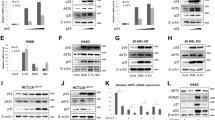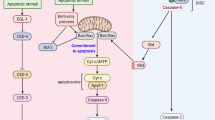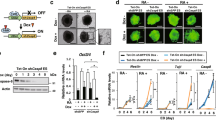Abstract
The tumor suppressor Rb (retinoblastoma protein) is known to regulate p53-dependent apoptosis, but the mechanisms involved are unclear. In a rat fibroblast model, we previously observed that caspase inhibition potentiates p53-dependent apoptosis and prevents the Rb cleavage associated with p53 activation. These results suggested that a caspase(s) can antagonize p53-mediated apoptosis via the production of a protective Rb truncated form. Here, we identify caspase-9 as the caspase that interferes, upstream of the mitochondrion, with p53-induced apoptosis in both immortalized and primary fibroblasts. This caspase can be detected as a p38 processed form in living cells, in the absence of apoptosome formation and apoptotic signal. We also provide evidence that the involvement of caspase-9 in a pre-mitochondrial protective pathway results from the previously undescribed cleavage of Rb, at a LExD site, into a p76Rb form, which antagonizes p53-induced apoptosis. These results establish that a truncated form of Rb can display an antiapoptotic activity, rather than just being a by-product of Rb degradation.
This is a preview of subscription content, access via your institution
Access options
Subscribe to this journal
Receive 50 print issues and online access
$259.00 per year
only $5.18 per issue
Buy this article
- Purchase on Springer Link
- Instant access to full article PDF
Prices may be subject to local taxes which are calculated during checkout






Similar content being viewed by others
References
Alam A, Cohen LY, Aouad S and Sekaly RP . (1999). J. Exp. Med., 190, 1879–1890.
An B and Dou QP . (1996). Cancer Res., 56, 438–442.
Angelastro JM, Moon NY, Liu DX, Yang AS, Greene LA and Franke TF . (2001). J. Biol. Chem., 276, 12190–12200.
Bitzer M, Armeanu S, Prinz F, Ungerechts G, Wybranietz W, Spiegel M, Bernlohr C, Cecconi F, Gregor M, Neubert WJ, Schulze-Osthoff K and Lauer UM . (2002). J. Biol. Chem., 277, 29817–29824.
Boutillier AL, Trinh E and Loeffler JP . (2000). Oncogene, 19, 2171–2178.
Bowen C, Spiegel S and Gelmann EP . (1998). Cancer Res., 58, 3275–3281.
Chandler JM, Alnemri ES, Cohen GM and MacFarlane M . (1997). Biochem. J., 322 (Part 1), 19–23.
Chen WD, Otterson GA, Lipkowitz S, Khleif SN, Coxon AB and Kaye FJ . (1997). Oncogene, 14, 1243–1248.
Cregan SP, MacLaurin JG, Craig CG, Robertson GS, Nicholson DW, Park DS and Slack RS . (1999). J. Neurosci., 19, 7860–7869.
De Maria R, Zeuner A, Eramo A, Domenichelli C, Bonci D, Grignani F, Srinivasula SM, Alnemri ES, Testa U and Peschle C . (1999). Nature, 401, 489–493.
Ding HF, Lin YL, McGill G, Juo P, Zhu H, Blenis J, Yuan J and Fisher DE . (2000). J. Biol. Chem., 275, 38905–38911.
Dyson N . (1998). Genes Dev., 12, 2245–2262.
Evan G and Littlewood T . (1998). Science, 281, 1317–1322.
Eymin B, Sordet O, Droin N, Munsch B, Haugg M, Van de Craen M, Vandenabeele P and Solary E . (1999). Oncogene, 18, 4839–4847.
Fattman CL, Delach SM, Dou QP and Johnson DE . (2001). Oncogene, 20, 2918–2926.
Fearnhead HO, Rodriguez J, Govek EE, Guo W, Kobayashi R, Hannon G and Lazebnik YA . (1998). Proc. Natl. Acad. Sci. USA, 95, 13664–13669.
Forcet C, Ye X, Granger L, Corset V, Shin H, Bredesen DE and Mehlen P . (2001). Proc. Natl. Acad. Sci. USA, 98, 3416–3421.
Friedlander P, Haupt Y, Prives C and Oren M . (1996). Mol. Cell. Biol., 16, 4961–4971.
Fujita E, Egashira J, Urase K, Kuida K and Momoi T . (2001). Cell Death Differ., 8, 335–344.
Gao CF, Ren S, Zhang L, Nakajima T, Ichinose S, Hara T, Koike K and Tsuchida N . (2001). Exp. Cell Res., 265, 145–151.
Godefroy N, Lemaire C, Renaud F, Rincheval V, Perez S, Parvu-Ferecatu I, Mignotte B and Vayssiere JL . (2004). Cell Death Differ., 11, 785–787.
Gottlieb E and Oren M . (1998). EMBO J., 17, 3587–3596.
Guenal I, Sidoti-de Fraisse C, Gaumer S and Mignotte B . (1997). Oncogene, 15, 347–360.
Harbour JW and Dean DC . (2000). Nat. Cell Biol., 2, E65–E67.
Haupt Y, Rowan S, Shaulian E, Vousden KH and Oren M . (1995). Genes Dev., 9, 2170–2183.
Hsieh JK, Chan FS, O'Connor DJ, Mittnacht S, Zhong S and Lu X . (1999). Mol. Cell, 3, 181–193.
Janicke RU, Walker PA, Lin XY and Porter AG . (1996). EMBO J., 15, 6969–6978.
Kaufmann SH and Hengartner MO . (2001). Trends Cell Biol., 11, 526–534.
Kennedy NJ, Kataoka T, Tschopp J and Budd RC . (1999). J. Exp. Med., 190, 1891–1896.
Knudsen KE, Weber E, Arden KC, Cavenee WK, Feramisco JR and Knudsen ES . (1999). Oncogene, 18, 5239–5245.
Lemaire C, Andréau K, Fraisse CS, Adam A and Souvannavong V . (1999). Cell Death Differ., 6, 813–820.
Lopez-Hernandez FJ, Ortiz MA, Bayon Y and Piedrafita FJ . (2004). Cell Death Differ., 11, 154–164.
Macleod K . (1999). Curr. Opin. Genet. Dev., 9, 31–39.
Malcomson RD, Oren M, Wyllie AH and Harrison DJ . (1995). Br. J. Cancer, 72, 952–957.
Martinez J, Georgoff I and Levine AJ . (1991). Genes Dev., 5, 151–159.
Mashima T, Naito M and Tsuruo T . (1999). Oncogene, 18, 2423–2430.
Micheau O and Tschopp J . (2003). Cell, 114, 181–190.
Petit CA, Gardes M and Feunteun J . (1983). Virology, 127, 74–82.
Pomerantz J, Schreiber-Agus N, Liegeois NJ, Silverman A, Alland L, Chin L, Potes J, Chen K, Orlow I, Lee HW, Cordon-Cardo C and DePinho RA . (1998). Cell, 92, 713–723.
Prives C . (1998). Cell, 95, 5–8.
Rincheval V, Renaud F, Lemaire C, Mignotte B and Vayssiere JL . (1999). FEBS Lett., 460, 203–206.
Ritter PM, Marti A, Blanc C, Baltzer A, Krajewski S, Reed JC and Jaggi R . (2000). Eur. J. Cell Biol., 79, 358–364.
Rudel T and Bokoch GM . (1997). Science, 276, 1571–1574.
Schuler M, Bossy-Wetzel E, Goldstein JC, Fitzgerald P and Green DR . (2000). J. Biol. Chem., 275, 7337–7342.
Seol DW and Billiar TR . (1999). J. Biol. Chem., 274, 2072–2076.
Shi Y . (2002). Mol. Cell, 9, 459–470.
Slinskey A, Barnes D and Pipas JM . (1999). J. Virol., 73, 6791–6799.
Soengas MS, Alarcon RM, Yoshida H, Giaccia AJ, Hakem R, Mak TW and Lowe SW . (1999). Science, 284, 156–159.
Srinivasula SM, Ahmad M, Fernandes-Alnemri T and Alnemri ES . (1998). Mol. Cell, 1, 949–957.
Srinivasula SM, Ahmad M, Guo Y, Zhan Y, Lazebnik Y, Fernandes-Alnemri T and Alnemri ES . (1999). Cancer Res., 59, 999–1002.
Stennicke HR, Deveraux QL, Humke EW, Reed JC, Dixit VM and Salvesen GS . (1999). J. Biol. Chem., 274, 8359–8362.
Symonds H, Krall L, Remington L, Saenz-Robles M, Lowe S, Jacks T and Van Dyke T . (1994). Cell, 78, 703–711.
Thompson CB . (1995). Science, 267, 1456–1462.
Vogelstein B, Lane D and Levine AJ . (2000). Nature, 408, 307–310.
Yang JY and Widmann C . (2001). Mol. Cell. Biol., 21, 5346–5358.
Zhang Y, Fujita N and Tsuruo T . (1999). Oncogene, 18, 1131–1138.
Zheng DQ, Vayssiere JL, Petit PX, LeCoeur H, Spatz A, Mignotte B and Feunteun J . (1994). Oncogene, 9, 3345–3351.
Zheng TS, Hunot S, Kuida K and Flavell RA . (1999). Cell Death Differ., 6, 1043–1053.
Acknowledgements
This work was supported by the University of Versailles/Saint Quentin, the Association pour la Recherche contre le Cancer (#4480) and the Ligue Nationale Contre le Cancer. CL was a fellow from the Ligue Nationale Contre le Cancer. NG is supported by a scholarship from the Ministère de l'Education Nationale, de l' Enseignement Supérieur et de la Recherche (MENESR). We thank Dr Laurent Theodore (University of Versailles, Versailles, France) and Dr Anne-Marie Pret (University Pierre et Marie Curie, Paris, France) for critical reading of the manuscript. The dominant negative caspase mutants were a kind gift from Dr Patrick Mehlen (Molecular and Cellular Genetic Center, Villeurbane, France).
Author information
Authors and Affiliations
Corresponding author
Rights and permissions
About this article
Cite this article
Lemaire, C., Godefroy, N., Costina-Parvu, I. et al. Caspase-9 can antagonize p53-induced apoptosis by generating a p76Rb truncated form of Rb. Oncogene 24, 3297–3308 (2005). https://doi.org/10.1038/sj.onc.1208493
Received:
Revised:
Accepted:
Published:
Issue Date:
DOI: https://doi.org/10.1038/sj.onc.1208493
Keywords
This article is cited by
-
Programmed expression of pro-apoptotic BMCC1 during apoptosis, triggered by DNA damage in neuroblastoma cells
BMC Cancer (2019)
-
Skin sensitizers differentially regulate signaling pathways in MUTZ-3 cells in relation to their individual potency
BMC Pharmacology and Toxicology (2014)
-
Kaposi’s sarcoma-associated herpesvirus lana2 protein interacts with the pocket proteins and inhibits their sumoylation
Oncogene (2014)
-
p38 phosphorylates Rb on Ser567 by a novel, cell cycle-independent mechanism that triggers Rb–Hdm2 interaction and apoptosis
Oncogene (2011)
-
The retinoblastoma tumor-suppressor gene, the exception that proves the rule
Oncogene (2006)



